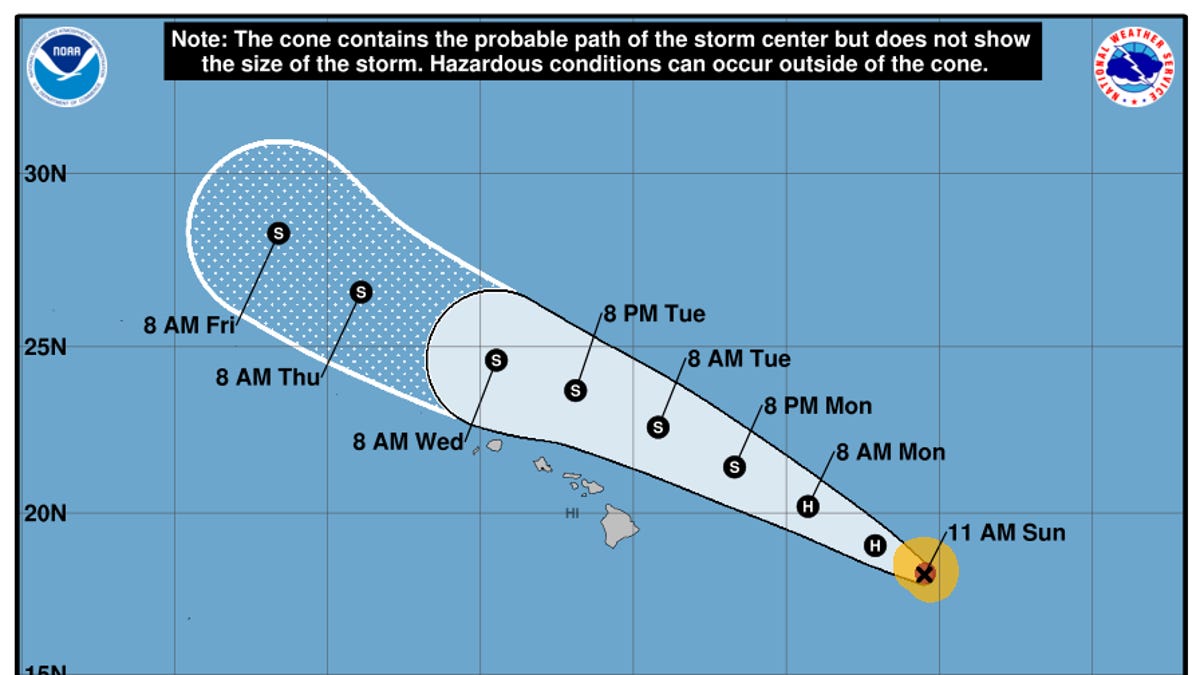Hawaii
Emotions run high as sea turtles take over popular Hawaii beach

A large crowd forms around sunset at Poipu Beach to witness a spectacle of basking Hawaiian green turtles.
Ashley Harrell/SFGATEJust before sunset on one of Hawaii’s premier stretches of beach, a sea turtle drags itself out of the surf and onto the sand to bask, as humans sunbathe and frolic nearby. A handful of people gather around the scaly, prehistoric-looking reptile, who naps peacefully despite the audience.
When a second turtle drifts into the shallow cove, it prompts squeals of excitement from the crowd. Then comes another. And another. And another.
Advertisement
Article continues below this ad
Soon, about a dozen Hawaiian green sea turtles — known as honu in Hawaiian — have scooted ashore and fallen asleep on Poipu Beach, a popular tourist spot on the island of Kauai. In response, a team of volunteers get to work, setting up safety cones and signage to keep back the semi-circle of onlookers sipping cocktails and snapping photos from 10 feet away. That’s as close as the public is legally allowed to get to green sea turtles, thanks to their status as a threatened species.
While someone plays “Somewhere Over the Rainbow” on a speaker, a small child darts away from his mother and runs giggling through the turtles.
“Oh, oh, oh, oh! No, no, no, no!” a volunteer cries, and the embarrassed parent reclaims her son.
A volunteer at Poipu Beach moves a cone into place to protect Hawaiian green sea turtles from encroaching visitors.
Ashley Harrell/SFGATEAdvertisement
Article continues below this ad
The turtles snooze through the drama, seemingly accustomed to the hubbub their presence now elicits on Poipu Beach every single night. And yet, until two years ago, sea turtles rarely came ashore on this beach.
Rampant overfishing reduced the population significantly in the mid-1900s; the few turtles left shied away from humans and the beaches they frequented most. But the population has slowly rebounded after environmental protections were enacted in the 1970s. In the 1990s, turtles began coming ashore to rest on beaches across the Hawaiian Islands, including some often frequented by people, such as Oahu’s Laniakea.
Two years ago, around when the pandemic led to the closure of many beaches, turtles began coming ashore here at Poipu Beach, one of the most visited beaches on Kauai. The phenomenon hasn’t stopped since restrictions were lifted, leading to the nightly ballet between eager tourists and volunteer protectors, who keep a watchful eye over as many as 100 turtles a night, the first time anyone can remember a time when turtles have arrived in these numbers, each and every night, on such a popular beach.
Hawaiian green sea turtles tend to bask in groups, suggesting the behavior may be social in some way.
Ashley Harrell/SFGATEAdvertisement
Article continues below this ad
How to manage such a spectacular event is anything but clear, and people are pretty much losing their minds over it.
“We haven’t had to navigate this before,” says Debbie Herrera, volunteer and education coordinator of Malama i na honu, the nonprofit group that organizes volunteer turtle protectors to watch over beaches on Oahu and Kauai. “Everyone is learning as we go.”
How the basking sea turtles started
The first published photo of a Hawaiian green turtle basking on a beach appeared in National Geographic Magazine in 1925. The caption read: “These grotesque creatures browse in submarine fields of algae until hunger is satisfied, and then crawl heavily out to sprawl in the sand, safe from enemies in the sea.”
Advertisement
Article continues below this ad
“These grotesque creatures browse in submarine fields of algae until hunger is satisfied, and then crawl in the sand safe from enemies of the sea. On one occasion, the author, while walking 300 yards along the beach on Lisianski Island, counted 80 of these creatures from fifteen inches to four feet in length. Others, feeding a few yards offshore, were hidden by ripples in the water and so escaped this casual census. Their only enemies seem to be sharks.” Lisianski Island, 1925
Photo by Alexander Wetmore/Courtesy of George BalaszBasking behavior among sea turtles is not fully understood, but that explanation is a pretty decent one, says sea turtle scientist George Balazs, who worked at the National Oceanic and Atmospheric Administration for almost half a century.
When Balazs began studying Hawaiian sea turtles in the early ’70s, he traveled to where the Nat Geo photo was taken, the French Frigate Shoals. The uninhabited islands are on the northwestern side of the Hawaiian archipelago, more than 500 miles from Kauai, and this is where Hawaiian green sea turtles typically come to lay their eggs. Although the turtles could often be seen basking on beaches around their nesting grounds, no records existed of them basking on inhabited Hawaiian Islands when Balazs began his work.
Through his research, he discovered that turtles were being overharvested by commercial fishermen. They were understandably afraid of humans, Balazs told me, and didn’t dare swim ashore on Hawaii’s inhabited islands. An ensnared 100-pound turtle fetched about $100 in the ’70s, he said, and the meat often landed in fancy restaurant dishes across the islands.
Advertisement
Article continues below this ad
A Hawaiian green sea turtle glides through the water near the Four Seasons Resort Hualalai, where basking behavior has been observed for many years.
Ashley Harrell/SFGATESea turtles had long been sacred to Native Hawaiians. When Balazs’ research showed a dramatic population decline — he documented a mere 67 sea turtles returning to their nesting grounds in 1973 — people rallied around the cause. In 1975, the state government banned the commercial harvest of sea turtles in Hawaii, and in 1978, the U.S. Fish and Wildlife Service and NOAA listed the Hawaiian green sea turtle as threatened, triggering protections against harassment, including the 10-foot rule. Their numbers began to recover rapidly, with the population growing at an average of about 5% per year, according to Balazs.
“The speed that the numbers recovered after the commercial fishing was absolutely shocking to me,” Balaszs told me.
Over time, the turtles seemed to lose their fear of humans. In the 1990s, something magnificent began to happen: The sea turtles started crawling out of the sea and resting on inhabited island beaches across Hawaii. One in particular — Oahu’s Laniakea Beach — got famous for it.
Advertisement
Article continues below this ad
How Hawaiian turtles became a tourist attraction
In March of 1999, a solitary green turtle began hauling itself out of the ocean and onto the vanilla-colored sands of Laniakea. The locals started calling him Brutus.
Herrera, the volunteer coordinator, distinctly remembers visiting the North Shore with her kids around that time and seeing Brutus. There weren’t many visitors at Laniakea Beach back then, she says, just some surfers and fishers. Although she had been living on the island for a couple of years, she had never seen a turtle crawl out of the water and onto the sand.
Hawaiian green sea turtles snooze on Kauai’s Poipu Beach.
Ashley Harrell/SFGATEAdvertisement
Article continues below this ad
“I called the Humane Society and I said, ‘There’s a turtle that I think is dead on the beach,’” Herrera says.
She was a schoolteacher then, with no background in marine science or turtle biology. She was aware that sea turtles came ashore to lay eggs on beaches, but like most people, she had no idea that they sometimes bask on land.
Of the seven species of sea turtles, only green turtles emerge from the water to bask. The phenomenon has been documented in just four places: the Galapagos, Socorro Island, Australia’s Wellesley Islands and the Hawaiian archipelago. After Brutus hauled out at Laniakea, more turtles followed. By 2005, 16 resident turtles were showing up regularly to bask. People also began to arrive in greater numbers, until tour buses were bringing hundreds of visitors a day. Some started calling Laniakea “Turtle Beach.” Some of those visitors would move in closer than 10 feet to the turtles, touching or even sitting on them.
Those interactions led Balazs, then the head of marine turtle research for the NOAA, to spearhead the “Show Turtles Aloha” campaign, which aimed to teach people about the turtles and minimize negative impacts on the animals. That work eventually turned into the nonprofit Malama i na honu, whose volunteers have been working daytime shifts and collecting data on Laniakea’s turtles since 2007, tracking anywhere from 500 to 1,200 instances of turtles basking on the beach per year.
Advertisement
Article continues below this ad
Visitors to Poipu Beach drink cocktails while turtle watching.
Ashley Harrell/SFGATETourists coming to see the turtles on Laniakea have created significant conflict, including gridlock from people parking illegally, which infuriated locals call “turtle traffic.” At least one crash has occurred, involving a 10-year-old pedestrian on an increasingly busy thoroughfare.
In 2021, when turtles began turning up on Poipu Beach, the Kauai community reached out to Malama i na honu to ask if the nonprofit could establish a volunteer program on Poipu Beach. But Herrera — who started volunteering with Malama i na honu in 2013, and has served as volunteer and education coordinator for the last 10 years — had her hands full at Laniakea. Her first response, she told me, was “absolutely not.”
Still, she flew over to Kauai to assess the situation, and couldn’t believe the sheer numbers of turtles that were crawling out of the sea to sleep on Poipu Beach every night. She knew something had to be done.
Advertisement
Article continues below this ad
“Like you and everyone else,” she told me, “I was flabbergasted.”
The problems with Poipu
On Poipu Beach, the sun has set behind the Pacific. But hundreds of visitors still linger, snapping photos and swimming in the ocean right where the turtles are waiting for a chance to come ashore.
A volunteer with Malama i na honu sets up a cone to prevent visitors at Poipu Beach from getting to close to basking, threatened sea turtles.
Ashley Harrell/SFGATEAdvertisement
Article continues below this ad
A volunteer in a cowgirl hat picks up her skirt and wades into the water. “At low tide, this is the hallway to their bedroom,” the volunteer explains to the swimmers. “Can we open up the door so they can come in and sleep?”
The swimmers comply, perhaps because they’ve been asked so nicely. That’s always the goal, Herrera tells me: not just to redirect people who are interfering with the turtles’ behavior, but to do it in a friendly, approachable way.
That isn’t always easy; volunteers have dealt with turtles being chased, straddled and scared off more times than they can count. It hasn’t helped that people have continuously posted photos and videos on social media, Herrera told me, which has led to the event growing ever more popular.
The crowds have created a trash problem, left bathrooms in unsanitary conditions and eroded a nearby bluff, Herrera added. And in truth, the volunteers don’t have very much authority. People are allowed to swim at Poipu Beach. People are allowed to fish. Although technically the volunteers could report visitors who refuse to remain 10 feet away from the turtles, that’s not the purpose of the program.
Advertisement
Article continues below this ad
If Herrera had her way, Kauai County would close the beach to visitors at night, giving it over to the turtles and local fishers, although there’s been no indication from that agency or any other that a beach closure is a possibility. (The county did not answer SFGATE’s inquiries about a possible closure.)
There is some evidence, though, that community leaders are starting to shift how they think about Poipu Beach. For instance, the Poipu Beach Foundation recently canceled its New Year’s fireworks show to avoid harassing the turtles, according to Sue Kanoho, executive director of Kauai Visitors Bureau.
There’s also an unspoken rule in Kauai that businesses will not promote the turtles as a tourist attraction, Kanoho told me, emphasizing the need to protect the wildlife. To that end, the bureau is planning a wildlife summit in January to ensure that Kauai’s tourism professionals are clear on the rules around endangered species.
Advertisement
Article continues below this ad
One of the signs on Kauai’s Poipu Beach reminds visitors of the rules around threatened Hawaiian green sea turtles.
Ashley Harrell/SFGATEIn the meantime, the volunteers of Malama i na honu will continue monitoring Poipu Beach each night, making gentle suggestions that people move back, adjusting safety cones as necessary, and teaching people how to take nighttime iPhone photos without using any flash. They will answer question after question, for as many hours as it takes, until visitors leave the beach for the night.
Inevitably, more people will come. And with any luck, so will more turtles. The hope is that Poipu, and all the other beaches where turtles have chosen to bask, can accommodate both.
“It’s about co-existing,” Herrera says. “I love the idea of people coming down and seeing it, because it’s amazing. It’s phenomenal. It’s beautiful. It’s all of those things. But when they walk away, I want to see it continue.”
Advertisement
Article continues below this ad
Editor’s note: SFGATE recognizes the importance of diacritical marks in the Hawaiian language. We are unable to use them due to the limitations of our publishing platform.
We have a newsletter all about Hawaii, with news, tips and in-depth features from the Aloha state. Sign up here.

Hawaii
Hawaii Set to Host First State Surfing Championship in 2026

Hawaii Governor Josh Green was joined by Carissa Moore Monday to announce the 2026 Hawaii High School Athletic Association (HHSAA) surfing competition. The contest will be held at Hookipa Beach on Maui’s north shore on May 1 and May 2 and will cap off the first school year in which surfing is an official team sport at the prep level in the Aloha State.
HHSAA announced that surfing would be added to its spring 2026 schedule back in July after Gov. Green signed a bill providing $685,000 in funding for the state’s interscholastic leagues. Prior to that, athletes like Carissa Moore were left with traveling to compete as individuals representing their schools in NSSA events.
“It would’ve been cool to have a few more of my peers alongside me competing and doing it together, and representing something bigger than ourselves,” Moore told the media on Monday. She joked about the complications it created as a student, making up missed P.E. credits with laps around the track at Punahou School. “Surfing is a very individual sport, and I think this team aspect is so important and something that I missed out on as a young person.”
The May 2026 event will include competition categories for both boys and girls in three different disciplines: shortboard, longboard, and bodyboard.
“The Maui high schools have competed for 19 years as an unofficial club sport and then from 10 years ago, we’ve been competing as an official MIL sport,” said Maui Interscholastic League surfing co-coordinator Kim Ball. “So you can imagine the enthusiasm and excitement after 29 years that we’re finally going to have a state championship. The county of Maui and our MIL surf crew will do all we can to make it a memorable event.”
The news is being celebrated around Hawaii for the sport’s importance within the state’s culture and history. Beyond that, however, it makes Hawaii the first state in the U.S. to recognize surfing as a state champion team event.
Hawaii
Shohei Ohtani’s lawyers claim he was victim in Hawaii real estate deal

HONOLULU — Dodgers star Shohei Ohtani and his agent, Nez Balelo, moved to dismiss a lawsuit filed last month accusing them of causing a Hawaii real estate investor and broker to be fired from a $240-million luxury housing development on the Big Island’s Hapuna Coast.
Ohtani and Balelo were sued Aug. 8 in Hawaii Circuit Court for the First Circuit by developer Kevin J. Hayes Sr. and real estate broker Tomoko Matsumoto, West Point Investment Corp. and Hapuna Estates Property Owners, who accused them of “abuse of power” that allegedly resulted in tortious interference and unjust enrichment.
Hayes and Matsumoto had been dropped from the development deal by Kingsbarn Realty Capital, the joint venture’s majority owner.
In papers filed Sunday, lawyers for Ohtani and Balelo said Hayes and Matsumoto in 2023 acquired rights for a joint venture in which they owned a minority percentage to use Ohtani’s name, image and likeness under an endorsement agreement to market the venture’s real estate development at the Mauna Kea Resort. The lawyers said Ohtani was a “victim of NIL violations.”
“Unbeknownst to Ohtani and his agent Nez Balelo, plaintiffs exploited Ohtani’s name and photograph to drum up traffic to a website that marketed plaintiffs’ own side project development,” the lawyers wrote. “They engaged in this self-dealing without authorization, and without paying Ohtani for that use, in a selfish and wrongful effort to take advantage of their proximity to the most famous baseball player in the world.”
The lawyers claimed Hayes and Matsumoto sued after “Balelo did his job and protected his client by expressing justifiable concern about this misuse and threatening to take legal action against this clear misappropriation.” They called Balelo’s actions “clearly protected speech “
In a statement issued after the suit was filed last month, Kingsbarn called the allegations “completely frivolous and without merit.”
Ohtani is a three-time MVP on the defending World Series champion Dodgers.
“Nez Balelo has always prioritized Shohei Ohtani’s best interests, including protecting his name, image, and likeness from unauthorized use,” a lawyer for Ohtani and Balelo, said in a statement. “This frivolous lawsuit is a desperate attempt by plaintiffs to distract from their myriad of failures and blatant misappropriation of Mr. Ohtani’s rights.”
Lawyers for Hayes and Matsumoto did not immediately respond to a request for comment.
Hawaii
Hawaii justices offer mixed ruling on Green’s housing proclamation | Honolulu Star-Advertiser
-

 Health1 week ago
Health1 week agoWho Makes Vaccine Policy Decisions in RFK Jr.’s Health Department?
-

 Finance4 days ago
Finance4 days agoReimagining Finance: Derek Kudsee on Coda’s AI-Powered Future
-

 Lifestyle1 week ago
Lifestyle1 week agoBobbi Brown doesn’t listen to men in suits about makeup : Wild Card with Rachel Martin
-

 Business1 week ago
Business1 week agoHow Nexstar’s Proposed TV Merger Is Tied to Jimmy Kimmel’s Suspension
-
North Dakota4 days ago
Board approves Brent Sanford as new ‘commissioner’ of North Dakota University System
-

 Technology3 days ago
Technology3 days agoThese earbuds include a tiny wired microphone you can hold
-

 Crypto3 days ago
Crypto3 days agoTexas brothers charged in cryptocurrency kidnapping, robbery in MN
-
World1 week ago
Russian jets enter Estonia's airspace in latest test for NATO




















